가톨릭 신앙생활 Q&A 코너
|
성모님께서 하느님의 어머니이신 성경 근거는? 1242_ |
|---|
|
2017-01-01 ㅣ No.1742
질문 1: 성모송 기도문의 후반부의 첫 구절은, "천주의 성모 마리아님" 로 시작하는데, "천주의 성모 마리아님", 즉, "하느님의 어머니이신 성 마리아님(Holy Mary, Mother of God)"에서, 성모님께서 "하느님의 어머니"이신 성경 근거는 무엇인지요?
질문 1에 대한 간략한 답변: 루카 복음서 1,43입니다.
1. 들어가면서 1-1. 매년 1월 1일은, 가톨릭 교회의 전례력에 있어, 천주의 성모 마리아 대축일입니다. 그리고 성모님께서 "천주의 성모", 즉, "하느님의 어머니"이심은, 성모님에 대한 가톨릭 교회의 네 개의 교의(dogmas, 믿을 교리)들 중의 그 첫 번쨰입니다.
1-2. 다음의 주소에 접속하면, 매년 1월 1일 천주의 성모 마리아 대축일 미사 중에 발췌되어 읽히는 제1독서(민수 6,22-27), 제2독서(갈라티아 4,4-7), 그리고 복음 말씀(루카 2,16-21)에 대한, 나바르 성경 주석서의 해설을 읽을 수 있는데, http://ch.catholic.or.kr/pundang/4/navarre/marymoth.htm
그러나 대단히 유감스럽게도, 이날 봉독되는 성경 본문들 어디에도, 성모님께서 "하느님의 어머니"로 불린다는 언급이 없음을 알 수 있고, 그리하여 그 결과, 이들 발췌된 성경 본문들에 대한 나바르 성경 주석서에도 성모님께서 "하느님의 어머니"로 불림이 성경 본문에 근거한다는 언급도 없음을 알 수 있습니다.
1-3. 바로 위의 제1-2항에서 말씀드린 바는 매년 1월 1일을 천주의 성모 마리아 대축일 로 경축하면서도 정작 해당일에 그러한 언급이 없는 것은, 그리스도교 신앙적으로 중요한 그 무엇이 빠뜨려졌다는 혹은 미사 참례자들에게 전달되지 못하고 있다는 생각이 들어, 이 글을 작성하게 되었습니다.
2. 2-1. 가톨릭 교회의 전례력에 있어, 루카 복음서 1,43이 포함된 부분이 발췌되어 봉독되는 날들은 다음과 같으며,
매년 12월 21일 복음 말씀(루카 1,39-45) http://ch.catholic.or.kr/pundang/4/navarre/Dec21.htm
다해 대림 제4주일 복음 말씀(루카 1,39-45)
매년 8월 15일 성모 승천 대축일 복음 말씀(루카 1,39-56) http://ch.catholic.or.kr/pundang/4/navarre/assumpt.htm
2-2. 그리고 루카 복음서 1,42-43에 대한 나바르 성경 주석서의 해설은 다음과 같습니다:
출처: http://ch.catholic.or.kr/pundang/4/navarre/Dec21.htm (발췌 시작) 42. St. Bede comments that Elizabeth blesses Mary using the same words as the archangel "to show that she should be honored by angels and by men and why she should indeed be revered above all other women" ("In Lucae Evangelium Expositio, in loc.").
42. 성 베다(St. Bede)는 엘리자벳이 "마리아가 천사들에 의하여 그리고 사람들에 의하여 마땅히 명예를 받게 되어야 함을 그리고 왜 그녀가 다른 여자들 모두보다 마땅히 정말로 존경을 받게 되어야함을 나타내는", 대천사와 동일한 단어들을 사용함으로써, 마리아를 축복한다고 주석합니다 [성 베다(St. Bede), In Lucae Evangelium Expositio, in loc."].
우리가 "성모송"을 기도할 때에 우리는, "하느님의 어머니로서 그녀의 품격에 계시는 마리아와 함께 기뻐함으로써 그리하여 주님을 찬양함으로써, 마리아를 통하여 예수 그리스도를 우리에게 제공해 오심에 대하여 당신께 감사드림으로써," 이들 신성적 인사(divine greetings)들을 반복합니다 ["성 비오 10세 교리서(St. Pius X Catechism)", 제333항].
43. 엘리자벳은 마리아를 "나의 주님의 어머니(the mother of my Lord)"라고 부르도록 성령에 의하여 움직여지는데, 그리하여 그 결과 바로 이것에 의하여(즉, 성령에 의하여 움직여짐에 의하여) 마리아께서 하느님의 어머니이심을 나타냅니다. (발췌 및 우리말 번역 끝)
2-3. 다음은 루카 복음서 1,43에 주어진 Haydock's Catholic Bible Commentary 1859 on DRB의 주석 전문입니다:
출처: http://haydock1859.tripod.com/id1731.html (발췌 시작) Ver. 43. The mother of my Lord. A proof that Christ was truly God, and the blessed Virgin Mary truly the mother of God. (Witham)
--- Elizabeth was a just and blessed woman; yet the excellency of the mother of God does so far surpass that of Elizabeth, and of every other woman, as the great luminary outshines the smaller stars. (St. Jerome præf. in Sophon.)
제43절. 나의 주님의 어머니. 그리스도께서 진실로 하느님이시고, 그리하여 복되신 동정 마이라께서 진실로 하느님의 어머니이심이라는 한 개의 증명(a proof). (Witham)
--- 엘리자벳은 한명의 의롭고 그리고 복받은 여자이나, 그럼에도 불구하고 하느님의 어머니의 탁월은 엘리자벳의, 그리고 모든 다른 여자의, 바로 그것을, 커다란 발광체가 더 작음 별들보다 강하게 빛나는 것처럼, 훨씬 멀리에까지 능가합니다. [성 예로니모(St. Jerome) præf. in Sophon]. (이상, 발췌 및 우리말 번역 끝)
2-4. 다음은 루카 복음서 1,43에 주어진 The Great Biblical Commentary of Cornelius a Lapide(1567-1637년)의 주석 전문입니다:
출처: http://www.corneliusbiblecommentary.faithweb.com/1luke.htm (발췌 시작) Ver. 43. — And whence is this to me, that the Mother of my Lord should come to me? These are words of the greatest humility and reverence; John imitated his mother, saying when Christ came to be baptized of him, “I have need to be baptized of Thee, and comest thou to me?”
Lord, that is God, Who is called absolutely the Lord, because He is King of kings and Lord of lords. Hence it is clear —
1. That the humanity of Christ was already in Christ endowed with life and united to the Word or Son of God. 2. That the Blessed Virgin is rightly called θεότοκος, i.e., Mother of God and not only χζιστότοκος, Mother of Christ, as Nestorius maintained. 3. That in Christ there are two natures, the human, for this alone could He take of His Virgin Mother; and the Divine, which the Father alone communicated to Him; but one Person, not human, but Divine.
For if in Christ there had been two persons, as there are two natures, God could not properly be said to have been born of a Virgin, to have suffered and been crucified, but another person, that is to say, a man, or the person of a man; but now it is properly so said, because there is one person in Christ; which is the reason why the attributes of the one nature may be ascribed in the concrete to the other, so that this man, Jesus, may properly be called God, eternal and Almighty; and on the other hand, God in Him may properly be called man, passible and mortal, yea, He may even be said to have suffered and died; because it is the same Person, which on account of the two natures which It has, is at the same time God and man, and accordingly assumes to Itself the actions and attributes both of God and man. For action belongs to persons; and this sole (divine) Person in Christ is signified alike by the word man, or Jesus, and by the word God or Son of God. Wherefore what is truly said of one is also truly said of the other. (이상, 발췌 끝)
2-5. 그리고 다음의 발췌된 바의 첫 파란색칠이 된 부분을 클릭하면 읽을 수 있는, 1635년에 초간된 쥬리오 아레니 신부님(1582-1649년)의 "천주강생언행기략"과 1636년에 초간된 주니오르 디아스 신부님(1574-1659년)의 "성경직해"를 통하여, 이벽 성조 등의 초기의 우리나라의 신앙의 선조들께서도 또한, 성모님께서 "하느님의 어머니" 혹은 이와 등가로 불리심을 이미 알고 계셨다는 생각입니다:
2-5-1. 출처: http://ch.catholic.or.kr/pundang/4/cb/1582-1649_쥬리오_아레니/1635_천주강생언행기략.htm ("천주강생언행기략"에서 발췌 시작) 권1_4_성모왕견의살백이_23-24(*1) [루카 복음서 1,39-56(매년 성모승천 대축일(8월 15일) 복음 말씀)] [의살백이 = 엘리사벳, 아파랑 = 아브라함, 달미 = 다윗] [(2016년 12월 7일) 주: "용약", "경외" 등의 번역 용어들이 사용됨. 그런데, "용약"이라는 번역 용어는, 다음에 있는, "천주강생언행기략" 초간본보다 늦게(즉, 1년 뒤에) 초간된 쥬니오르 디아스 신부님(1574-1659년)의 한문본 "성경직해"에서도 또한 사용되고 있음: 성경직해, 권10_13_성모왕견성부의살백이첨례_199-206]
----- (*1) 게시자 주: 여기서 성모님은 "오주지모(吾主之母, 나의 주님의 어머니)"라고 불리고 있음. 바로 위에 발췌된 바에서, 왼쪽에서 두 번째 열(column)을 보라. ----- (이상, 발췌 끝)
2-5-2. 출처: http://ch.catholic.or.kr/pundang/4/cb/1574-1659_엠마누엘_주니오르_디아스/1636_천주강생성경직해.htm ("성경직해"에서 발췌 시작) 권10_13_성모왕견성부의살백이첨례_199-206(*2) [루카 복음서 1,39-48(1969년에 개정된 지금의 전례력에 있어, 매년 성모승천 대축일(몽소승천 대축일)(8월 15일) 복음 말씀)]
----- (*2) 게시자 주: 여기서 성모님은 "오주성모(吾主聖母, 나의 주님의 성모)"라고 불리고 있음. 바로 위에 발췌된 바에서, 왼쪽에서 두 번째 열(column)을 보라. ----- (이상, 발췌 끝)
2-6. 그런데 예상밖으로, "주석 성경"에 주어진 루카 복음서 1,43의 각주에는 엘리자벳이 말한 "나의 주님의 어머니"가 성모님께서 "하느님의 어머니"이심의 성경 근거라는 언급이 전혀 없습니다.
게시자 주 2-6: 이 지적에 대하여 혹시라도 이견이 있으신 분들께서는, 위의 제2-1항에서부터 이미 전달해 드린 바들 뿐만이 아니라, 특히 바로 아래에 이어지는 제3항에서 전달해드리는 바를 잘 읽어보시기 바랍니다.
3. 3-1. 다른 한편으로, 성모님께서 "하느님의 어머니"로 불림의 성경 근거가 루카 복음서 1,43임은, 다음에 발췌된 가톨릭 교회 교리서 제495항에서, 루카 복음서 1,43에 있는 "나의 주님의 어머니"를 발췌 인용하면서, 명확하게 가르치고 있습니다:
출처: http://www.vatican.va/archive/ccc_css/archive/catechism/p122a3p2.htm (발췌 시작) CCC 495 Called in the Gospels "the mother of Jesus", Mary is acclaimed by Elizabeth, at the prompting of the Spirit and even before the birth of her son, as "the mother of my Lord".144 In fact, the One whom she conceived as man by the Holy Spirit, who truly became her Son according to the flesh, was none other than the Father's eternal Son, the second person of the Holy Trinity. Hence the Church confesses that Mary is truly "Mother of God" (Theotokos).145
----- 144 Lk 1:43; Jn 2:1; 19:25; cf. Mt 13:55; et al. -----
CCC 495 복음서들에서 "예수님의 어머니"라고 불리는, 마리아는 엘리자벳에 의하여, 거룩한 영(the Spirit)의 재촉 행위(prompting)에 따라 그리고 심지어 그녀의 아들(her son)의 탄생 이전에, "나의 주님의 어머니(the mother of my Lord)"로서 환호를 받게 됩니다.144 사실, 육에 따라 그녀의 아드님(Son)이 되신, 성령(the Holy Spirit)에 의하여 사람(man)으로서 그녀가 잉태한, 바로 그 한 분(the One)께서는, 성삼위의 두 번째 위격이신, 성부의 영원한 아드님 바로 그분이십니다. 따라서 교회는 마리아가 진실로 "하느님의 어머니(the Mother of God, Theotokos)"이심을 고백합니다.145
----- 144 루카 복음서 1,43; 요한 복음서 2,1; 19,25; 마태오 복음서 13:55 참조; 등 등. ----- (이상, 발췌 및 우리말 번역 끝)
3-2. 다음은, 미사 중의 강론(Homily)의 주제에 포함될 내용들을 위하여 프란치스코 교황님께서 최근에 마련해 주신, "주일/대축일 강론과 가톨릭 교회 교리서"에서 발췌한 바입니다. 여기서 맨 앞에 있는 CCCC 는 가톨릭 교회 교리서 요약편을 말하는데, 이 부분은 필자가 추가한 것입니다:
출처: http://ch.catholic.or.kr/pundang/4/soh/CCC4주일및대축일_전례력.htm (발췌 시작) 천주의 성모 마리아 대축일 (1월 1일) (The Solemnity of Mary, the Mother of God)
(이상, 발췌 끝)
3-3. 끝으로, 다음의 주소에 접속하면, 성서학자이신 베네딕토 16세 교황님의 2008년 1월 2일 수요일 "일반 알현" 교리 교육용 강론 말씀[제목: 하느님의 어머니이신 마리아]을 읽을 수 있습니다:
출처: http://w2.vatican.va/content/benedict-xvi/en/audiences/2008/documents/hf_ben-xvi_aud_20080102.html (발췌 시작) [...] Yesterday, we celebrated the solemn Feast of Mary, Mother of God. "Mother of God", Theotokos, is the title that was officially attributed to Mary in the fifth century, to be exact, at the Council of Ephesus in 431, but which had already taken root in the devotion of the Christian people since the third century, in the context of the heated discussions on the Person of Christ in that period. This title highlights the fact that Christ is God and truly was born of Mary as a man: in this way his unity as true God and true man is preserved. Actually, however much the debate might seem to focus on Mary, it essentially concerned the Son. Desiring to safeguard the full humanity of Jesus, several Fathers suggested a weaker term: instead of the title Theotokos, they suggested Christotokos, "Mother of Christ"; however, this was rightly seen as a threat to the doctrine of the full unity of Christ's divinity with his humanity. On the one hand, therefore, after lengthy discussion at the Council of Ephesus in 431, as I said, the unity of the two natures - the divine and the human (cf. DS, n. 250) - in the Person of the Son of God was solemnly confirmed and, on the other, the legitimacy of the attribution of the title Theotokos, Mother of God, to the Virgin (ibid., n. 251).
After this Council a true explosion of Marian devotion was recorded and many churches dedicated to the Mother of God were built. Outstanding among these is the Basilica of St Mary Major here in Rome. The teaching on Mary, Mother of God, received further confirmation at the Council of Chalcedon (451), at which Christ was declared "true God and true man... born for us and for our salvation of Mary, Virgin and Mother of God, in his humanity" (DS, n. 301). As is well known, the Second Vatican Council gathered the teachings on Mary in the eighth chapter of the Dogmatic Constitution on the Church Lumen Gentium, reaffirming her divine motherhood. The chapter is entitled "The Blessed Virgin Mary, Mother of God, in the Mystery of Christ and the Church". [...] (이상, 발췌 끝)
천주의 성모 마리아께서는 찬미받으소서!
---------- 작성자: 교수 소순태 마태오 (Ph.D.) 작업에 소요된 시간: 약3시간
0 1,217 2 |


